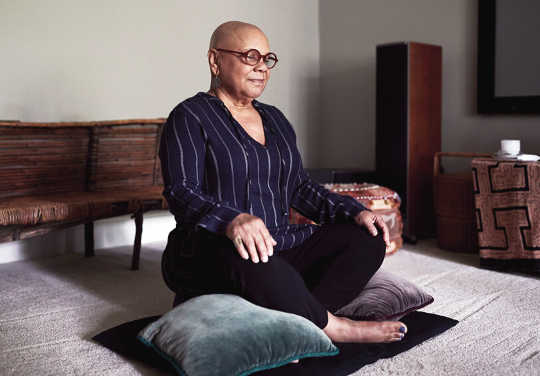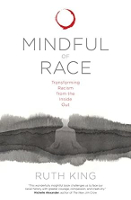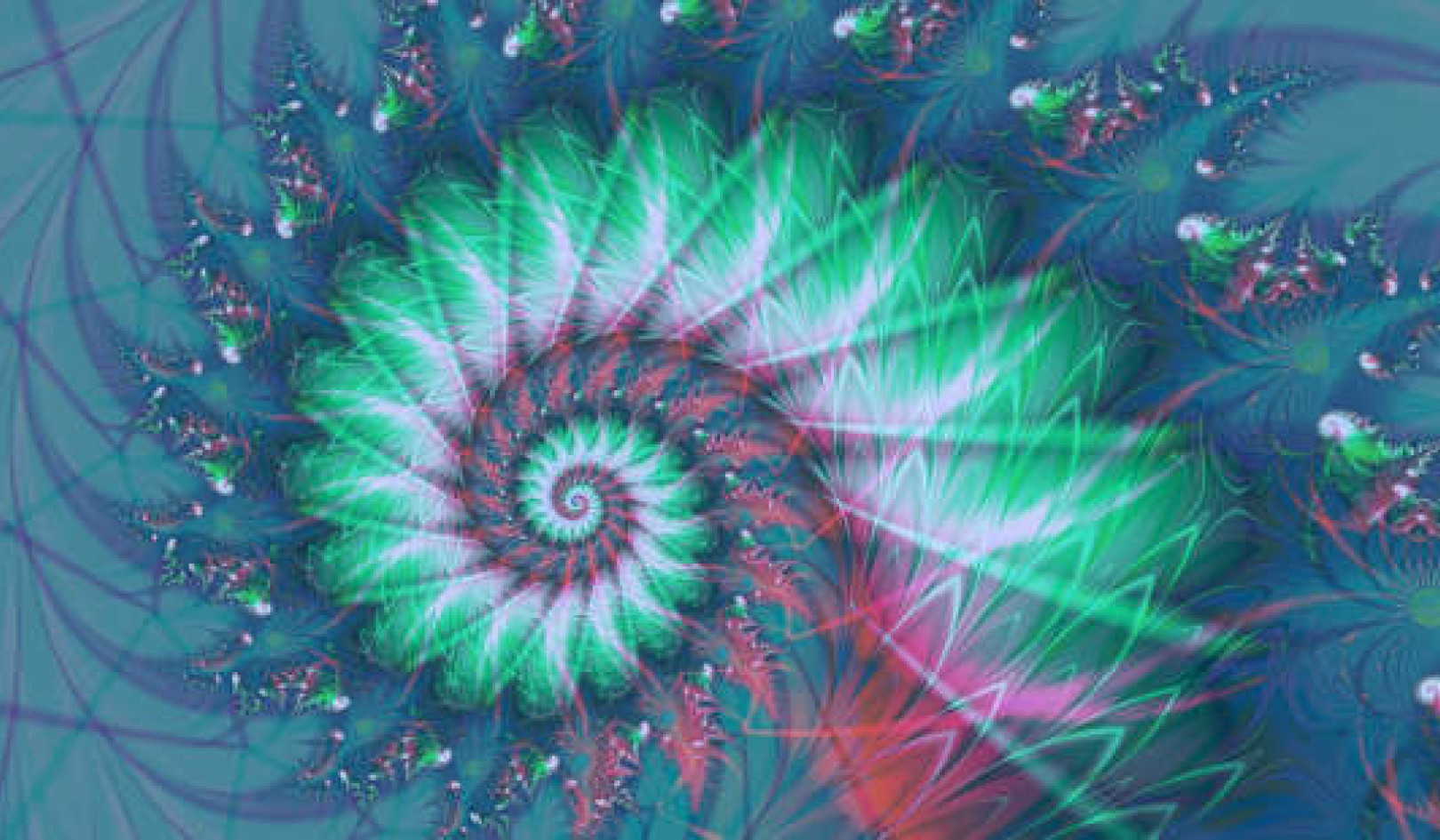
Ruth King. Photo by Bill Miles.
In 1985, I had a dream. I had finished grad school and moved to Santa Cruz, California, what many referred to as the mecca of spiritual materialism, which I took full advantage of.
In a six-week dream course, I dreamed of being a large, round body seated on a flower in the middle of a still lake. There was a torrential rain. The rain was like chiseled ice, and etched in the ice were body parts, like ears giving off frightening sounds, noses giving off dreadful smells, tongues wagging hatred, and ridiculing faces of people I had been at war with throughout my life, screaming their blameless stories. A shitstorm does not begin to describe this gruesome scene—all attacking and condemning my body. Strangely, through it all, my experience was one of calmness and ease—seated upright and dignified, undisturbed by what was happening.
This dream was unlike the way in which I had known my life to this point. The chiseled rain part was familiar, as life had earned me a Ph.D. in trauma and distress. But to experience peace amid it all was indeed foreign, yet so potent it compelled me into a deep investigation of my life.
I grew up in South Central Los Angeles, in a family of eight children raised by my mother, who was frequently a single mom. My mother and our community were intensely involved in the civil rights and Black Power movements of the 1960s. I was raised in the Baptist Church, where my mother was the choir director and pianist. I remember the lyrics of a song that she would often sing before getting ready to do something important: “Give me a clean heart so that I may serve you.” It’s funny what we remember from our past, but this song, “Give Me a Clean Heart,” also became my mantra.
Healing Rage Through an Open Heart
I was a sensitive and tenderhearted child. I was called a crybaby and teased because I was short, “nappy headed,” and wore hand-me-down clothes from my older and taller sisters. My fighting words were “You hurt my feelings.” I had a desperate need to know Why?! Why did they want to hurt me? I didn’t have the language or understanding that I do now to express how vulnerable I was to the energies of the world, and how this energy riveted my body.
I grew up in a family atmosphere of fear, high control, and violence. Emotionally, I often felt gut punched by words and ambiguity. Life felt scary, and I simply didn’t know what to do with my tenderness. What I knew was that it was dangerous to have it.
Growing up, it was normal for me to feel emotionally inflamed—not just from family struggles, but also from knowing that people like me, Black people, were systemically hated. I grew up watching my great-grandmother pace and worry herself because she could not protect the bodies of her Black children. I remember one time saying to myself, “I’m not going out like that!” I refused to worry myself to death. But my bigger heartbreak was that there was nothing I could do to console her. This was a broad distress in my family and within the Black community.
I became a teenage mom, giving birth to my son a few months prior to my 16th birthday. When I was 17, my father was murdered by his girlfriend in a jealous rage. The year was 1965; I remember it vividly. Holding my 2-year-old son so tight as we went to my father’s funeral, right in the thick of the Watts riots, I felt intense fear and then rage. The rage was overpowering. I had no sense or skill of how to keep it under wraps, having held it for so long.
In my mid-20s, I was advancing in the career of organizational development and consulting Fortune 500 companies on leadership, diversity, and the behavioral implications of mergers and acquisitions. I was also in a second graduate program to become a clinical psychologist. While my background brought awareness and understanding, it did not transform my relationship to rage or racial distress. I moved through the world like a barely contained volcano, well dressed in designer suits, well paid, and wrapped tightly in righteous indignation. Why change?
At the age of 27, I had open-heart surgery for a mitral valve prolapse. Two of my mother’s siblings had gone into the hospital for something simple and never came out, so she had an intense fear of hospitals and institutions run by White people. My mother was convinced that I wasn’t going to come out of the surgery alive. I remember how she filled the hospital room with a lot of folks who prayed all night. I looked around and asked, “Who are these people?” Mom said, “Don’t matter.” Among them was a stranger, of whom she said: “Well, I just picked this one off the street because they look like they have some good mojo.”
Can you imagine the risk I took as a Black woman, saying yes to open-heart surgery, knowing I would face disapproval from my mother, fearing that she might be right—that I was being an absolute fool for allowing White people to “experiment” with my heart? But I had to say yes to the surgery. I was the walking dead. Rage was both keeping me alive and killing me.
What was interesting about the heart surgery is that in retrospect, I can see how the surgical procedure was in fact the beginning of a spiritual journey of openheartedness, reparation, and reclaiming tenderness. Living on red alert and in constant racial defense, I had to surrender to the perceived “White enemy” surgeon and give over my heart. In fact, the surgeon had more access to my heart than I did at the time.
During my recovery from surgery, I had a past-life reading with a shaman. She shared that prior to this life, I had been in silence for 40 years, and that I was in such resistance coming into this noisy life that my heart stopped beating in the birth canal. As you can imagine, this added new flavor to the inherent need for heart reparation. Is it possible that I was carrying more than this lifetime was dishing out? Could I also be carrying the unresolved rage and resistance of my ancestors? And their love? Could I sit, big-bodied on a flower, on a still lake, in utter ease, while the thundering world is on fire?
As I continued to recover, I experienced shuddering moments of humility. I had been shocked back into my body, a gift I hadn’t appreciated before. And I was beginning to realize that we are deeply interdependent, despite all my efforts to resist that truth. I found myself crazed with curiosity about how we construct ourselves and how we heal—not just what’s wrong, but also what’s possible.
My professional training gave me the skills to design training programs for leaders, so I designed Celebration of Rage, a nationwide retreat for women that I led for more than 15 years, culminating in my first book, published in 2007, Healing Rage: Women Making Inner Peace Possible. My second book, Mindful of Race: Transforming Racism from the Inside Out, came out in 2018, and since then, I have been leading retreats on this body of work. Both publications are ways of looking at systems and navigating a reduction in emotional distress and an increase in social harmony.
Learning to Navigate Systems
My father owned a plumbing business that he inherited from my grandfather. I’ll never forget the time he showed me the layout of a plumbing system underneath a construction site. I was 11 and in awe of all the lines, wires, networks, and routings underneath the beauty of the buildings, invisible to the passing eye. He pointed out why connections needed to fit and explained how certain pipes needed to be higher and others lower for the water to flow—for the entire system to function optimally. This rare and memorable experience with my father was a profound life lesson that showed me there is an invisible mechanism at work that connects us, and if unattended, backs up. That’s true for all of us who are healing. We have this body, and then there’s this emotional wiring inside shaping how we relate to ourselves and others. Yet we can always check our plumbing by turning inward and asking: Where in my heart, body, and mind am I stuck? Can I adjust to facilitate flow? Can I open up to how the system (not just my self-interest) can function well?
My mother, alone, was a system that supported me in navigating the choppy waters of life. “Queen,” musician, and activist, she embodied an unapologetic strength and clarity that made you sit upright with a strong core in her presence. Her integrity was high and her tolerance for nonsense was low. Hers was a dance of fierce truth, deep listening, responding, good timing, and intention. Her walk made the wind sing, “I’m just not having it, so clear the way!” She was too busy to say much or explain, but I grew up seeing the strength in her body, the clarity in her eyes, and the magic in her fingers and heart when she played the piano, fried chicken, or slapped our asses. I couldn’t understand how she figured out her life—a life so weighted by injustice. And that was her point! Hers was a system of deep faith and improvisation. I discovered myself through her insistence that I not be her. She left me shaking in strength but standing in truth. She would often say, “Make your life work!”
Becoming a mother, discovering I was lesbian, and training in organizational development and clinical psychology were also profound systems, as was traveling to many parts of the world and experiencing diverse cultures.
In 1995, I was invited to teach a workshop on generational healing at the World Conference on Women in Beijing, China. On a side tour, I found myself facing what appeared to be a four-story golden Buddha, strikingly like the image in my dream. The guide explained that the image depicted the Buddha, sitting on the lotus flower of becoming, and having a peaceful fight with Mara, the lord of destruction. This brought tears to my eyes and meaning to the dream I had experienced nine years earlier. When I looked to my left, a stunning African American woman was standing next to me. She, too, had tears in her eyes. She whispered, “Do you meditate?” I said, “Kinda.” Her next question was “Where do you live?” Smiling broadly, we discovered that we both lived in the Bay Area of California. Months later, Marlene Jones Schoonover, Ed.D., would invite me to hear her teacher, Jack Kornfield, co-founder of Spirit Rock Meditation Center, a spiritual training institution grounded in the Buddha’s teachings. Marlene was on the board of Spirit Rock and chaired the Spirit Rock Diversity Council, which she co-founded.
I was not surprised to find that I was attracted to Buddhism—an exquisite system, offering a path of introspection, compassion, and freedom from suffering. At Marlene’s invitation, I not only joined her on the diversity council at Spirit Rock, but I also joined an intimate wisdom circle of eight women of color organized by Alice Walker and Jack Kornfield to study the dharma, the Buddhist teachings. We met monthly in the Bay Area for 10 years until I moved to Charlotte, North Carolina, to join my wife. Two years later, Jack invited me to be a Spirit Rock teacher, and later I became part of the faculty for the Dedicated Practitioners Program, a two-year program teaching the fundamentals of Buddhism and mindfulness meditation.
The practice of Buddhism has opened me to a vast field of understanding that supports experiences of liberation not dependent on external circumstances. With practice, I’ve softened into an understanding of the web of humanity and the extremes of our programming—corruption and innocence, purity and savagery, receptivity and force, distance and intimacy, wisdom and irrationality. Each of us is navigating such extremes, often clumsily, and with great bruising and inadequate responses. To recognize this as our social conditioning opened my eyes and softened the muscles of my heart. I could feel my breath moving in my body and I could rest more in my skin. I was allowing myself to feel the tenderness that the crybaby longed for!
As I wrote in my book Mindful of Race, Buddhism has, over time, impacted how I relate to both racial distress and racism in my relationships and communities. Through mindfulness meditation practice, I’ve been able to put a crucial pause between my instinctive and often overwhelming feelings and responses. In that pause, I’ve learned that one gains perspective. As I shared in my book, “I was able to see my choices more clearly and began to respond to racism more wisely. I have not reached nirvana, but I do know the freedom that comes from being able to look at what is happening—not what my mind is programmed to believe is happening, but what is really happening—without raging inside. The dream of ease and equipoise amid the storms of life was becoming more internalized.”
Given that the Buddha specialized in suffering, it made sense to me that I would create a training program that would weave my professional background in psychology and cultural systems with Buddhist principles and mindfulness practices aimed at alleviating racial distress. Following the publication of Mindful of Race, I established the Mindful of Race Institute in 2021, offering organizational consulting and a range of mindfulness-based racial-awareness online study programs.
Applying Universal Laws of Nature, of Being
Mindfulness practice is central to the work of the Mindful of Race Institute. What makes mindfulness practice distinct from ordinary awareness is an understanding of three universal laws: Nothing in life is Personal, Permanent, or Perfect.
Not Personal: Anything can happen to us at any time; life happens. Yet there is no enduring or reliable self. We are a series of ever-changing elemental processes; each feeling, thought, and action arising and passing away. Shit happens, and sometimes it happens
to us!
Not Permanent: Change is constant. Everything in life has an element of dissatisfaction and surprise because it does not last forever. All phenomena arise and pass away. Thank goodness we are not who we were five years or five minutes ago! We are constantly changing, as is everything and everyone else.
Not Perfect: Whatever happens in life is unreliable, unpredictable, and imperfect. The puppy is cute until it poops on your couch. Your lover is amazing until they die. We are not in control of what happens, yet we are responsible for improvements.
These natural laws are fundamental to the nature of our existence. I often give the example of gravity, which “has a nature, it’s not personal: Once you understand gravity, you don’t drop a glass and expect space to catch it. Seasons also have a nature—they are not perfect or permanent. Once you understand the seasons, you know how to dress and go out into the world.”
Relatedly, race—not being who we are, but as a social construct—points out the nature of our diversity. I’ve spoken to and written extensively about this in Mindful of Race as a wisdom principle—a way of perceiving and reducing racial distress. “In and of itself, race is not personal, nor is it a problem. The problem is how we perceive race, socially project onto race, and relate to race as if it were personal (all about our individual or racial group experience), permanent (the idea that views about race never change), or perfect (the idea that whatever is happening in this moment should be to my liking or meet my standard of what’s right).”
Over the years, reminding myself that life overall—not just race—is not personal, permanent, or perfect has kept me from destroying rooms with rage. It’s allowed me to pause and reflect on what supports distress and what supports a release from distress.
I often will invite students to pause and ask themselves, “What’s happening? Where am I holding tension right now? Am I taking this situation personally—as a personal experience instead of a human experience? How many people before me have felt this way? Where else in the world are people feeling similarly trapped? Do I believe that how it is now is how it will always be? Am I distressed because I am insisting that this situation be other than it is, right here and now? Can it be any other way right now? How can I care for the pain I’m in here and now? And what action can I take that would inspire belonging?”
Without wise awareness—an awareness that nothing in life is personal, permanent, or perfect—habitual patterns that are often harmful rule our lives. But if we practice stilling ourselves and being in the present moment without preferences, we can recognize the impact that the right now is having on us.
There is no greater healing or liberation than to, in this potent pause, ask and have answered, “Is how I am thinking and feeling contributing to suffering or to freedom?” This reflection can allow us to see more clearly our own reflection and that of the world, as we are one with all that surrounds us. With such clarity, we can do what must be done on both an individual and a collective level with empathy and understanding.
Now, back to my dream. I invite you to consider that it is a dream for all of us, an invocation to take a seat on our own lotus of wisdom—upright, resolute, and without apology, on the still waters of our mind. Remember that we belong to each other, and know that with wise awareness, we can weather life’s storms. And, if you like, take as your own my mantra from my mom: Give me a clean heart so that I may serve you.
This article originally appeared on YES! Magazine
Book by this Author: Mindful of Race
Mindful of Race: Transforming Racism from the Inside Out
by Ruth King.
 Drawing on her expertise as a meditation teacher and diversity consultant, Ruth King helps readers of all backgrounds examine with fresh eyes the complexity of racial identity and the dynamics of oppression.
Drawing on her expertise as a meditation teacher and diversity consultant, Ruth King helps readers of all backgrounds examine with fresh eyes the complexity of racial identity and the dynamics of oppression.
Ruth offers guided instructions on how to work with our own role in the story of race and shows us how to cultivate a culture of care to come to a place of greater clarity and compassion.
Click here for for info or to order this book.
 About The Author
About The Author
Ruth King is the founder of the Mindful of Race Institute. She is a professionally trained psychologist and organizational development consultant, and a celebrated author, educator, and meditation teacher.
Check out her website: ruthking.net

























